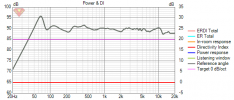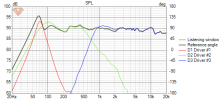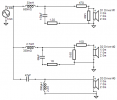Very illuminating simulation,
@ctrl. I had wanted to make a similar analysis just with words, but decided not to because I couldn't back it up with graphs. Thank you very much for taking the time.
Below the crossover frequency the pattern will be the familiar dipole figure-8, with a directivity index fairly similar to what the tweeter is doing north of the crossover frequency, though the radiation pattern shapes will obviously be very different.
In my opinion the different pattern shapes above and below the 575-Hz crossover region won't be a problem. Each is wide enough to provide exceptionally uniform coverage across a 60 degree arc, which should cover the listening area and then some, given proper set-up (which includes some toe-in). There will be significant spectral variation in the individual reflections, but the average spectral balance of the reflections will be unusually smooth. The ear tends to perceive the average spectral balance of reflections over a time interval, rather than the spectral balance of individual reflections. That time interval is in the 10-15 milliseconds ballpark as I recall.
As a result the perceived spectral balance of the reverberant sound (and yes I know the use of this term is problematic in the context of small rooms) will probably track the spectral balance of the direct sound fairly closely over most of the spectrum.
So despite how counter-intuitive it seems to combine a 15" woofer with a (rather large) dome tweeter, the Spatial Audio M3 is imo an example of how to do it right.
 normalized FR deg0 vs deg60
normalized FR deg0 vs deg60




